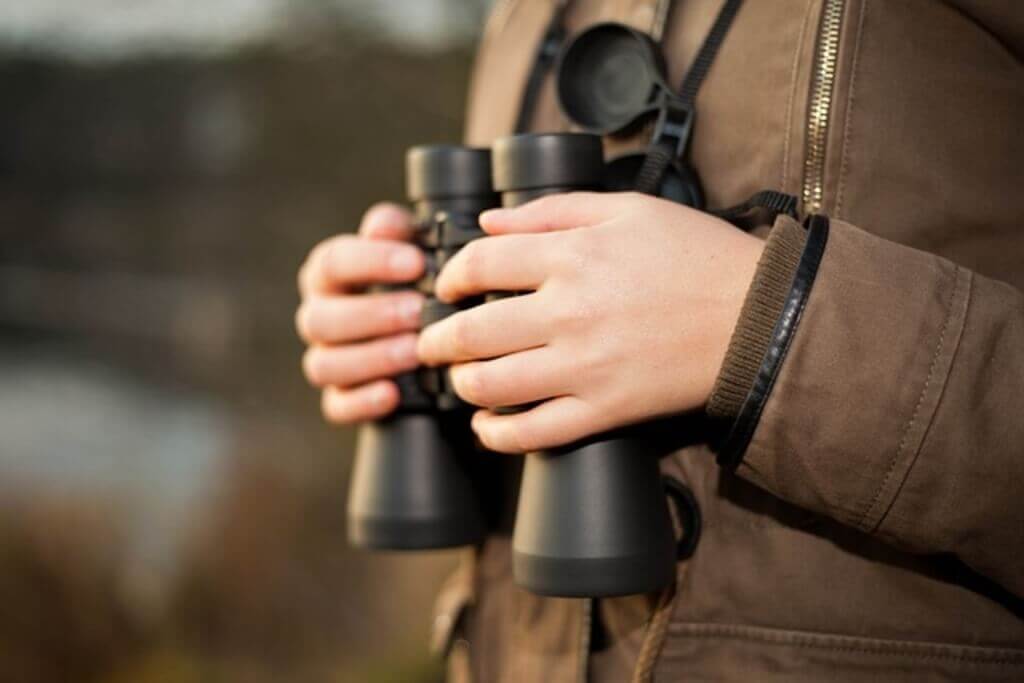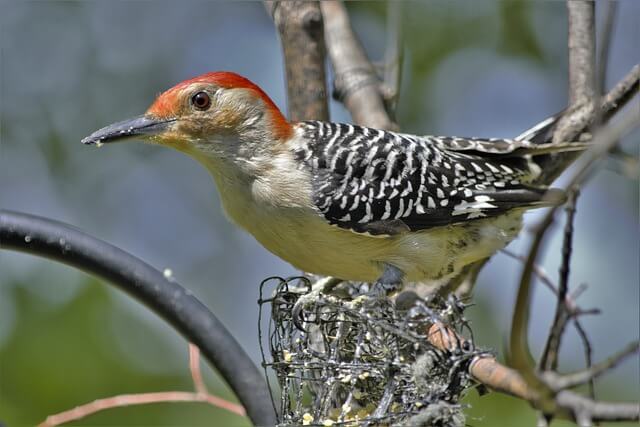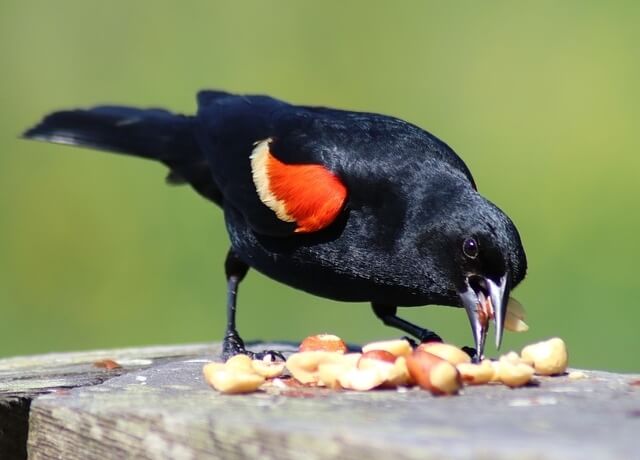Embark on a journey through the vibrant avian world of Kansas as we unveil the intricate tapestry of its backyard bird population. In this comprehensive guide, we’ll unveil the “Most Common Backyard Birds in Kansas”: the 65 most common feathered visitors that grace the gardens and skies of the Sunflower State.
From the cheerful chirps of cardinals to the graceful flights of mourning doves, each species contributes to the rich biodiversity of Kansas’s backyard habitats. Whether you’re a seasoned birder or a curious nature enthusiast, prepare to be captivated by the beauty and diversity of Kansas’s avian residents.
Table of Contents [show]
Most Common Backyard Birds in Kansas
Northern Cardinal
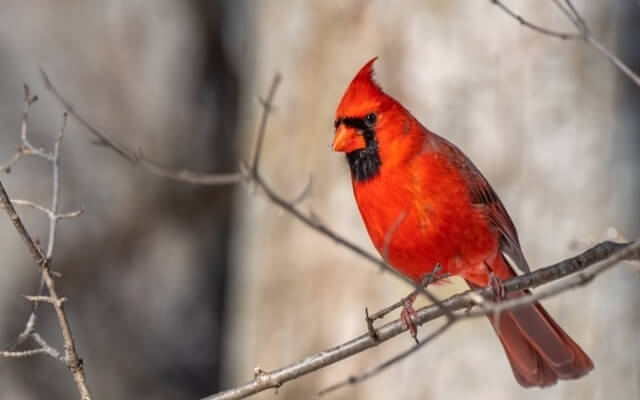
Northern Cardinal is a beautiful red bird common in Kansas. The cardinal is easily identified by their bright, rich, crimson feathers and the distinctive crest on their head. They can grow up to 10 inches long with a wingspan of 15 inches and weigh between 2-3 ounces. Females have an orange breast while males sport a more red coloration that is slightly duller than their female counterparts’.
The Northern Cardinal prefers to eat seeds from fruit or nuts, but they will also eat insects and eggs. It can be found in woodlands and parks all across North America, although it prefers to live near water sources such as streams or ponds.
- Frequency: 48.17%
- Color: Mostly red with a black mask on the face
- Habitat: woodlands, gardens, parks, backyards, and wetlands
- Range: USA, Canada, Mexico
- Size: 8.2 – 9.3″ inches
- Weight: 33 – 65 grams
- Diet: Fruits, berries, and insects (grasshoppers, beetles, snails, cicadas)
- Family: Cardinalidae
- Genus: Cardinalis
American Robin
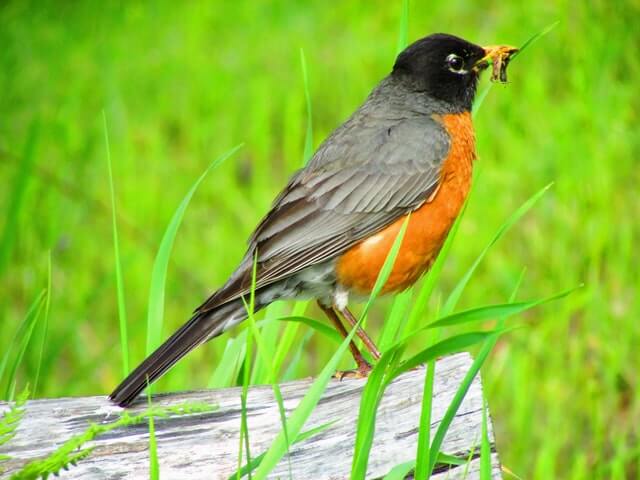
The American Robin is a common bird in Kansas and throughout North America. They can be found in urban areas, suburbs, rural towns, open countrysides and other habitats across the state. American Robins are recognizable by their robin red breast, black head and grayish-black plumage.
These birds feed on insects like flies, caterpillars, grasshoppers, beetles, earthworms, spiders, snails, slugs but will also eat seeds from fruit trees or any kind of seed they find on the ground, as well as berries from fruit-bearing plants like elderberry.
- Frequency: 41.19%
- Color: Mostly brown on the back with an orange-colored breast
- Habitat: Wooded areas, backyards, parks, fields
- Range: USA, Canada, Mexico
- Size: 12 – 16″ inches in length
- Weight: 72 – 95 grams
- Diet: Fruits, berries, and insects (earthworms, beetles, caterpillars
- Family: Turdidae
- Genus: Turdus
Mourning Dove

Mourning Doves inhabit eastern North America and some parts of the southwest United States where they feed on seeds, grains, fruit and insects during the summer months before migrating south for winter hibernation. The mourning dove’s natural habitat includes fields, gardens, forest edges and parks.
The bird is well known for its beautiful song which consists of a series of soft coos followed by musical trills which usually lasts from 30 seconds to 1 minute. Mourning doves nest in fields, thickets, and on the ground.
- Frequency: 41.04%
- Color: Light gray-brown and lighter and pinkish below. The wings have black spots.
- Habitat: Open habitats, urban areas, farms, prairie, grassland, wooded area
- Range: USA, Canada, Mexico, Central America, Greater Antilles
- Size: 12″ inches length
- Weight: 112 – 170 grams
- Diet: Rapeseed, corn, millet, safflower, sunflower seeds, pokeberry, sesame, and wheat.
- Family: Columbidae
- Genus: Zenaida
Blue Jay

Blue Jays are medium-sized, omnivorous birds that have a distinct blue and black coloration. They are usually found in North America, but can also be seen in Europe and Asia. The Blue Jay is an intelligent bird that feeds on seeds, fruits, nuts, berries and insects as well as scavenging for food on the ground or catching prey from other animals.
This includes frogs, worms and even snakes! The Blue Jay’s diet changes depending on what it finds during its travels. They are most commonly seen during the winter, but sightings have been recorded as early as February and as late as November.
- Frequency: 38.78%
- Color: Blue crest on the head, wings, back, and tail, and has a white face and belly
- Habitat: Deciduous and mixed forests, mixed woodlands, backyards, parks
- Range: Southern Canada, Eastern and Central United States, Florida and Texas
- Size: 8 – 12″ inches
- Weight: 70 – 100 grams
- Diet: Nuts, seeds, caterpillars, grasshoppers, and beetles
- Family: Corvidae
- Genus: Cyanocitta
American Crow

 Mabel Amber, who will one day from Pixabay
Mabel Amber, who will one day from PixabayThe American Crow is a large bird with an iridescent black plumage that is common in North America. It can be found throughout the continental United States, as well as southern Canada and northern Mexico, and it has adapted well to urban environments.
American Crows are omnivores and will eat whatever they can find that’s edible including insects, carrion, eggs, earthworms, lizards, snakes, mice, fruit and garbage. The birds prefer to nest near water or on rocky cliffs, but they can also be found nesting in large trees or even man-made structures such as power lines.
- Frequency: 33.36%
- Color: Black
- Habitat: Open country, farms, parks, woodlands, towns, cities
- Range: Canada, USA, Mexico
- Size: 16 – 21″ inches in length
- Weight: 315 -620 grams
- Diet: invertebrates, carrion, seeds, eggs fish, grains, mice, frogs, and other small animals.
- Family: Corvidae
- Genus: Corvis
European Starling
The European Starling is a medium-sized passerine bird native to most of Europe, Western Asia. The male has glossy black plumage with an iridescent sheen, speckled with white at the edges of the wings and back. Females and young birds are browner.
The European Starling was introduced to North America in the 1890s, and it has been widely successful and established itself, especially in urban areas where it can find plenty of places to nest. These birds will eat anything they can find including plants, insects, fruits and even smaller animals such as rodents.
- Frequency: 32.20%
- Color: Black with glossy iridescence plumage
- Habitat: Forests, woodlands, backyards, edges, yards, and parks
- Range: North America, Europe, Africa, India, Middle East, China
- Size: 7 – 9″ inches long
- Weight: 60 – 100 grams
- Diet: Insects (ants, beetles, invertebrates), fruits, seeds, berries
- Family: Picadae
- Genus: Colaptes
Red-bellied Woodpecker
The Red-bellied Woodpecker is a beautiful bird that has a light gray face, a red cap and nape, a white belly with a reddish tinge, and a patterned black and white bars on its wings and tail feathers that are quite striking when they flash in flight. Red-bellied Woodpeckers are fairly common in the eastern United States, where they inhabit deciduous forests, suburbs, and orchards from southern Canada to Florida.
The underside of their beak is light grayish-blue. It feeds on small insects and the larvae of wood boring beetles. They nest in trees or logs, building large nests of twigs lined with moss and bark strips.
- Frequency: 32.14%
- Color: Gray on body and face and underparts. Black and white pattern on wings, back, and tail.
- Habitat: Forests, backyards
- Range: Southern Canada, Eastern United States, Florida
- Size: 9 – 10.6″ inches long
- Weight: 56 -91 grams
- Diet: Insects, tree frogs, eggs of small birds, oozing sap, and small fish.
- Family: Picidae
- Genus: Melanerpes
Black-capped Chickadee

The Black-capped Chickadee is a very common and small bird that year round across North America, with migration occurring south for winter. They have a black cap, white cheeks, yellowish underparts, gray back and wings with black wing bars. They are omnivores, meaning they eat both plants and animals such as caterpillars, spiders, berries, seeds, insects or other small invertebrates.
The Black-capped Chickadee lives in many habitats, and you can spot them anywhere from forests, suburban yards, and backyards with tall trees and scattered shrubs. They typically build their nests in tree cavities close to the ground and often use old woodpecker holes for nesting.
- Frequency: 31.78%
- Color: Black cap, white on face, white/reddish-brown flanks
- Habitat: Deciduous and mixed forests, backyards, parks
- Range: USA and Canada
- Size: 11.5 -16 cm length
- Weight: 8 – 15 grams
- Diet: Insects, seeds, berries
- Family: Paridae
- Genus: Poecile
Red-winged Blackbird
The Red-winged Blackbird is a common sight in North America. The Red-winged Blackbird can be found all over the United States except for parts of California, Oregon, Nevada, Utah and Arizona. They have distinctive red and yellow patches on their wings that can be seen when the bird is flying or sitting still. They like hanging around lawns, orchards, golf courses, farmlands and other open spaces with plenty of water.
They nest in trees or shrubs close to the ground but are known for building their nests high up in the trees during the breeding season. The diet of the Red-winged Blackbird includes insects such as flies and beetles to seeds from fruit trees. In winter they migrate to warmer climates or go south for the winter.
- Frequency: 29.20%
- Color: All black with red patches on shoulder and a yellow wing bar
- Habitat: Deciduous forests, conifers, roadside, rivers, backyards, parks
- Range: North America, Central America
- Size: 6.7 – 7.1″ inches length
- Weight: 41.5 – 65 grams
- Diet: Seeds and insects (butterflies, dragonflies, moths, frogs, worms, spider, snails, carrion, flies.)
- Family: Icteridae
- Genus: Agelaius
American Goldfinch

The American Goldfinch is a small bird that is a frequent visitor to feeders and gardens throughout the United States and Canada, with an exception to the Great Lakes region. The American Goldfinch is a small bird with a black head and bright yellow body. It has a slender beak, which it uses to feed on seeds and fruits from trees and bushes.
They are known for their habit of gleaning insects from the bark of trees as well as eating the larvae that live in tree cavities. Goldfinches live near open spaces like parks or yards with trees, shrubs, or hedges where they can build their nests.
- Frequency: 28.90%
- Color: Face, neck, and underside are yellow, black wings with white bars
- Habitat: Deciduous forests and thickets, roadside, grasslands, backyards, meadows
- Range: Canada, USA, and Mexico
- Size: 4.3 – 5.5″ inches length
- Weight: 12 -18 grams
- Diet: Grass, dandelions, chickweed, sunflowers and ragweed, thistle, red alder, birch, spruce seeds
- Family: Carduelinae
- Genus: Spinus
Downy Woodpecker

Downy Woodpeckers are one of the most common woodpecker species in North America. They often spend their time pecking on trees, looking for insects to eat. The Downy Woodpecker has a red crown and a black-and-white striped back with white feathers underneath its wings that help it blend into tree bark.
They are often seen on the ground searching for food and will occasionally fly up to peck at tree bark, which they then pull away from the trunk with their beak. Woodpeckers make nests by drilling holes into trees and adding lining inside them before laying eggs. The Downy Woodpecker’s diet consists mainly of insects such as ants, beetles, and spiders that it finds while on the ground.
- Frequency: 28.14%
- Color: Black with a white throat, belly, and back. White spots on wings
- Habitat: Deciduous forests and thickets, roadside, grasslands, backyards, parks
- Range: Canada, USA, and Mexico
- Size: 5.5 – 7.1″ inches in length
- Weight: 20 – 33 grams
- Diet: Mostly insects and beetles and ants, also gall wasps, caterpillars
- Family: Picadae
- Genus: Dryobates
Red-tailed Hawk
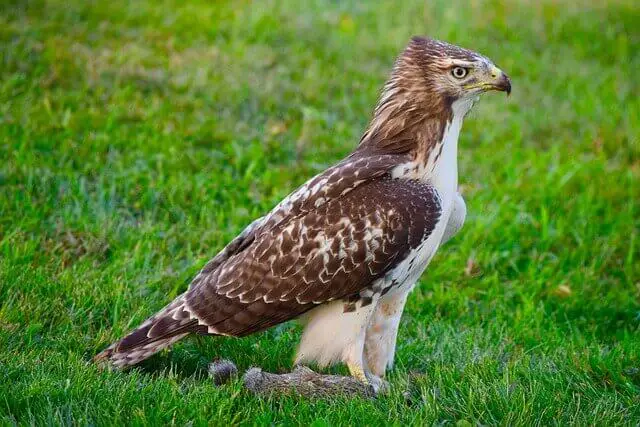
The Red-tailed Hawk is one of the most common hawks in North America and can be found near open fields or farms. It was named after the reddish-brown feathers on its tail, which are easily seen when they fly. These red-colored raptors will swoop down from the sky in search for food, which they usually find on the ground, such as rodents, rabbits, squirrels, chipmunks, rats and small birds and other small animals such as lizards and snakes.
The red-tailed hawk have a wingspan of up to six feet and can weigh as much as two pounds. When nesting season arrives these predators will often steal eggs from other birds or even eat their young if given the chance.
- Frequency: 26.84%
- Color: Brown back, nape and head, with white shoulders, and a rufous colored tail
- Habitat: Deciduous forests and thickets, roadside, grasslands, backyards, parks
- Range: Canada, USA, Central America
- Size: 20 – 26″ inches in length
- Weight: 1.50 – 2.42 lbs.
- Diet: Mice, rabbits, squirrels, rats, birds
- Family: Accipitridae
- Genus: Buteo
Dark-eyed Junco
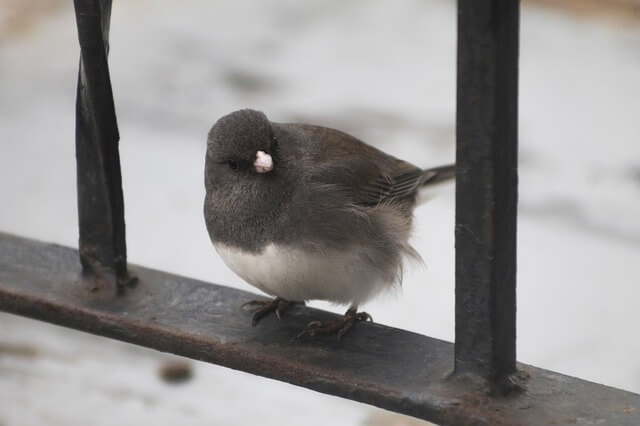
The Dark-eyed Junco is a species of small American sparrow that can be found in the Western United States, Canada, Mexico, Central America, and parts of South America. They are small birds measuring just 5 inches long with a wingspan of 9 inches and have gray feathers throughout, and a white belly. The Dark-eyed Junco lives mainly in trees or bushes, but it sometimes also nests on the ground.
They are most commonly found near streams or wooded areas where they find food such as berries, seeds, insects, larvae and snails. It will stay in the same area year round or migrate to another area depending on the time of year; it may also change its habitat depending on what food sources are available at that time.
- Frequency: 26.53%
- Color: Gray head, neck, breast, gray/brown backs and wings, white underside
- Habitat: Wooded areas, forest edges, roadsides, gardens, parks.
- Range: USA and Canada
- Size: 5.1 – 6.9″ inches
- Weight: 18 – 30 grams
- Diet: Seeds, insects, and arthropods
- Family: Passeriformes
- Genus: Junco
House Sparrow
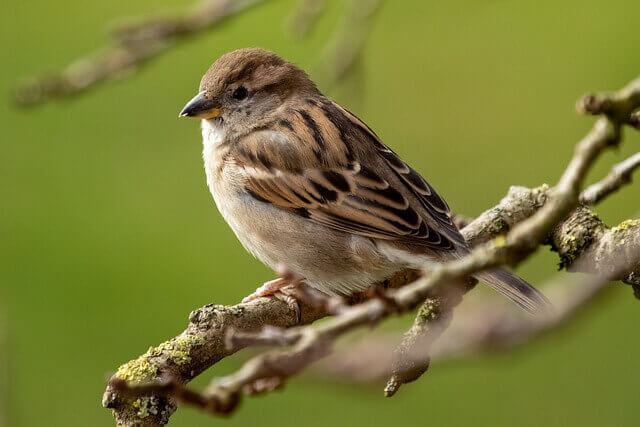
House sparrows are small birds with light brown and gray feathers. They can be found throughout the world in places such as Africa, Asia, Europe, North America and South America. House sparrows eat insects such as flies and beetles, fruits and grains. It lives in a variety of habitats including cities, suburbs, and agricultural areas.
It has adapted well to human development by living on our buildings as opposed to nesting high up in trees. They have become one of the most common birds found on sidewalks, in parks and residential areas because they can survive well around people.
- Frequency: 25.60%
- Color: Gray head marking, a reddish-brown back, and gray underparts
- Habitat: Urban centers, suburban areas, backyards, edges, yards, and parks
- Range: North America, Central America, South America, Africa, Australia, New Zealand
- Size: 5.5 – 7.1″ inches in length
- Weight: 25 – 39 grams
- Diet: Insects, beetles, caterpillars, aphids,, grasshoppers, crustaceans, earthworms, vertebrates
- Family: Passeridea
- Genus: Passer
Eastern Bluebird
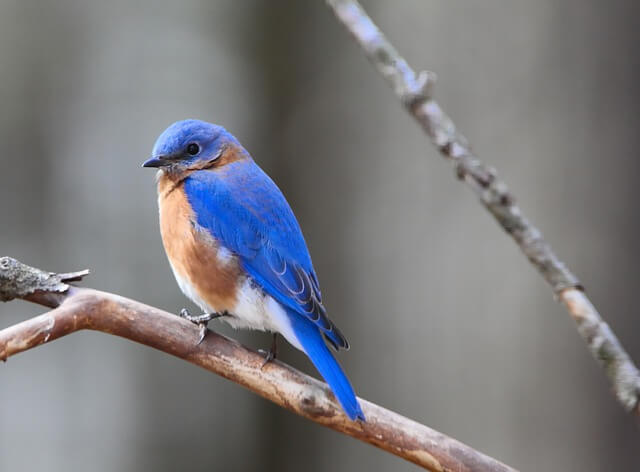
The Eastern Bluebird is a beautiful songbird that lives throughout eastern North America from Nova Scotia all the way down to Florida and as far west as Kansas and Texas.These birds have a bright blue head, back, and wings with rust-colored throat and breast. Males tend to be bluer than females because they have more of the brownish red pigment called carotenoids in their feathers.
Females are paler because they don’t get enough of this pigment from their diet or from sunlight during migration for breeding season. Eastern Bluebirds eat insects from the ground or catch them in flight to feed their younglings or themselves during breeding season (March to September). Eastern Bluebirds typically make their nests in tree cavities or other protected locations on the ground.
- Frequency: 23.73%
- Color: A Blue head, back, and wings. reddish-brown breast
- Habitat: Open woodlands, farmlands, and orchards.
- Range: Southern Canada to the Gulf states, East of the Rockies and south to Arizona to Nicaragua
- Size: 5.5 – 7.1″ inches in length
- Weight: 20 – 33 grams
- Diet: insects and other invertebrates
- Family: Turdidae
- Genus: Sialia
Carolina Wren
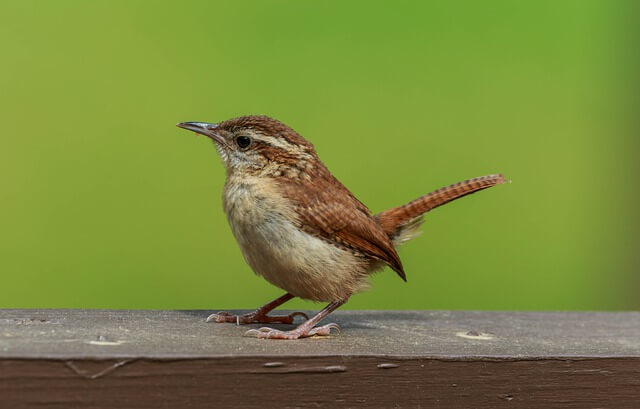
Carolina Wrens are birds that live in eastern states of America like Virginia, North Carolina, South Carolina, Georgia, Tennessee, Kentucky etc. They have an average wingspan of eleven inches and are about 5.5″ inches long. The wren can be seen anywhere from wetlands to forest edges, urban parks, backyards, and even suburban yards with trees or bushes.
They prefer habitats that have dense undergrowth and thick vegetation for nesting sites. These birds are most active during twilight hours which may contribute to their shyness around humans. The Carolina Wrens nests on trees close to water sources for food and it will defend its territory if threatened by other animals.
- Frequency: 23.47%
- Color: Reddish-brown upper and buff-orange color under, with a white chin, throat. White stripe on the eyebrow.
- Habitat: woodlands, gardens, parks, backyards, and wetlands
- Range: USA, Canada, Mexico
- Size: 5.0 – 5.5″ inches long
- Weight: 18 – 23 grams
- Diet: Fruits, berries seeds, and insects (Caterpillars, beetles, true bugs, grasshoppers, crickets, spiders, millipedes, snails)
- Family: Troglodytidae
- Genus: Thryothorus
Tufted Titmouse
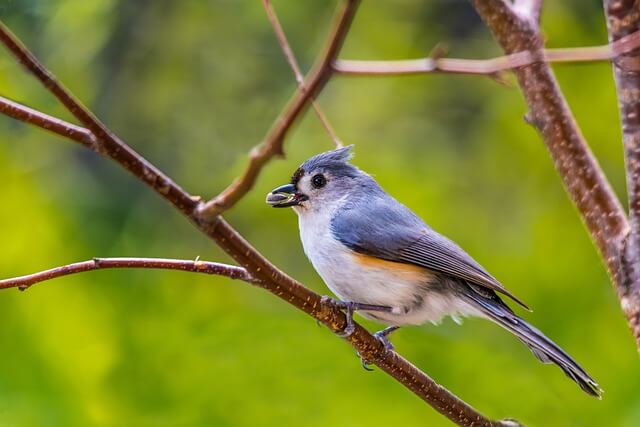
Tufted titmice are small birds about 6″ long with a white front, and gray upper body outlined with reddish-brown sides. They have brown eyes, dark beaks, and tufts of feathers on their heads. Titmice live in coniferous forests in the eastern United States and Canada. They can be found in North America from British Columbia to Florida and Texas. If you’re not careful, you may just walk right past the tufted titmouse.
This tiny bird is often overlooked because of its size and color. The Tufted Titmouse can be found in many different habitats such as meadows, woodlands, chaparral scrub, orchards and hedgerows. they prefer to eat insects such as beetles or spiders; seeds from pine cones or oak acorns; tree sap; fungi like mushrooms or lichens that grow on trees.
- Frequency: 23.41%
- Color: Gray upper, white front, a tufted gray crest on the head
- Habitat: Deciduous forests, river basin, backyards, swamps
- Range: Canada, USA, and Mexico
- Size: 5.5 – 6.4″ inches
- Weight: 18 – 26 grams
- Diet: Nuts, insects, berries, seeds small fruit, and snails
- Family: Paridae
- Genus: Baeolophus
Northern Flicker
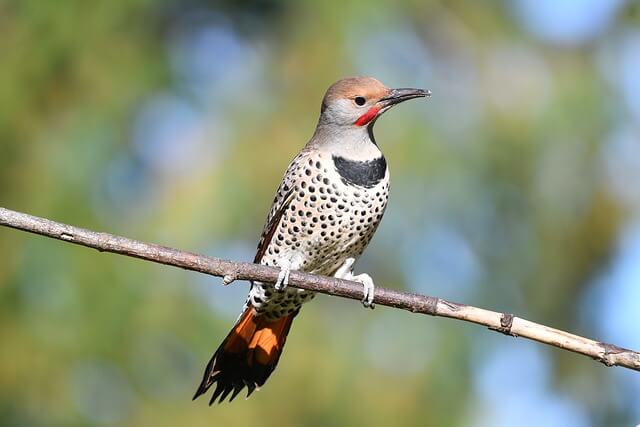
The Northern Flicker is a medium-sized, mostly brown woodpecker. It has two color phases: red and yellow, with the latter being more common in North America. Northern Flickers are found in deciduous forests across the continent. They forage on trees or bushes near woodland streams for insects and larvae to eat.
Northern Flickers may be seen year round as they migrate from their summer breeding grounds to wintering areas farther south each fall and back again northward. The flicker’s diet consists mainly of ants, beetles, caterpillars, centipedes, grasshoppers and spiders. When it locates its prey it pecks at them with its beak until they’re dead or until they escape from the flicker’s grasp.
- Frequency: 23.06%
- Color: Light brown with black bars across back, chest, wings, belly
- Habitat: Forests, woodlands, backyards, edges, yards, and parks
- Range: North America, Central America, Cuba, Cayman Islands
- Size: 10 – 14″ inches
- Weight: 85 – 165 grams
- Diet: Insects (ants, beetles, invertebrates), fruits, seeds, berries
- Family: Picadae
- Genus: Colaptes
House Finch
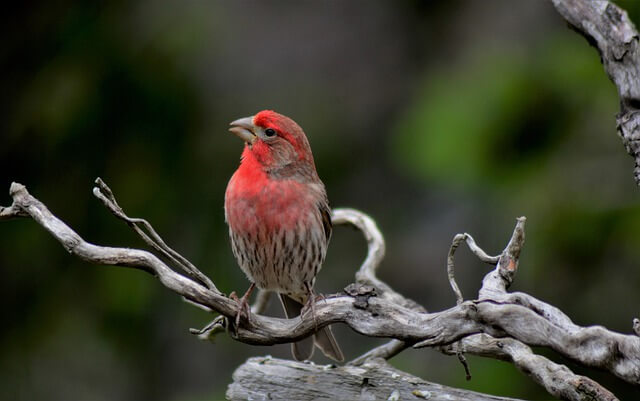
The House Finch is a beautiful bird that is common in North America. They have streaks of orange and brown on its head. It has an olive-green back and wings that are brown at the tips. They are sometimes confused with the more similar Purple Finch, but have different coloration on their heads and breast. The House Finch can be found year-round in most of Canada and all throughout the United States.
House Finches primarily eat seeds from wild grasses, weeds, berries, flowers and tree buds which they either find on the ground or break off branches to get at them. House finches often hide in tree bark, nests, birdhouses, crevices of buildings and other shelters when they feel threatened or are cold at night.
- Frequency: 22.13%
- Color: Reddish face and upper breast, brown streaks on back, belly, and tail.
- Habitat: urban and suburban areas, backyards, edges, yards, and parks
- Range: Canada, USA, Mexico
- Size: 5 – 6″ inches
- Weight: 16 – 27 grams
- Diet: Aphids, grains, seeds, berries, nettle, dandelion, sunflower
- Family: Fringillidae
- Genus: Haemorhous
Killdeer

The killdeer is a large plover that are not native to the United States, but migrate here in the spring and summer months. These birds are very territorial, meaning they will chase off other species that enter their territory. The male of this species also attracts females by pretending to have a broken wing, which he drags along on his back until she approaches him.
Once she gets close enough he takes off into the air with her following closely behind him. They are most often seen in fields and near water sources where they hunt for insects, frogs, or worms. Killdeers also eat snakes, slugs, and snails as well as carrion (dead animals). The killdeer has been known to attack other small birds by jumping on them while trying to steal their eggs or nestlings.
- Frequency: 20.79%
- Color: Brown-tan on upper body and white underneath. The white chest has two black bands, brown face with black and white patches.
- Habitat: Beach habitats and coastal wetlands and fields
- Range: USA, Southern Canada, and Mexico
- Size: 7.9 – 11″ inches long
- Weight: 72 – 120 grams
- Diet: Millipedes, worms, snails, spiders, and some seeds
- Family: Charadriidae
- Genus: Charadrius
Common Grackle
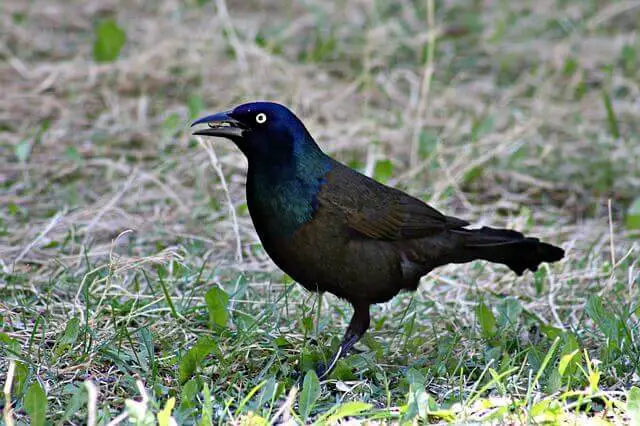
The Common Grackle is not a native species to North America but rather an invasive bird from Europe and Asia. They typically feed on the ground, and they will eat just about anything you give them including garbage. Grackles live in huge colonies of hundreds of individuals with complex social structures. The Common Grackle is a black iridescent bird that has been seen around the world.
The grackle is commonly found in North America, South America, Europe, Asia and Africa. This type of bird lives near water and often inhabits trees in parks or residential areas. These birds tend to eat insects, fish, amphibians, earthworms and small mammals such as mice or rats. They are known to steal shiny objects like coins from unsuspecting humans so be careful!
- Frequency: 18.62%
- Color: Black overall with a blue, and purple iridescence. Its body plumage is a shimmering copper color.
- Habitat: Woodlands, marshes, meadows, parks, backyards and fields
- Range: East of the Canadian Rockies, Canada and the United States
- Size: 11 – 13″ inches length
- Weight: 75 – 143 grams
- Diet: minnows, eggs, berries, seeds, grain, insects, frogs, mice
- Family: Icteridae
- Genus: Quiscalus
White-breasted Nuthatch
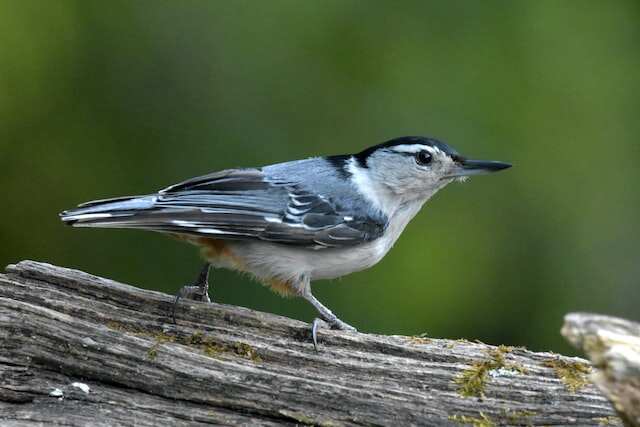
The White-breasted Nuthatch is a common visitor to the backyard bird feeder. It is one of the most conspicuous and widespread species in North America, found from southern Canada to Central America. They are primarily seed eaters, but they will also eat insects and berries when available.They have strong bills which they use to cut through tree bark and find insects or seeds inside of it.
In winter, White-breasted Nuthatches will forage near homes looking for sunflower seeds, peanuts, and suet to store in their granary trees during the colder months. In early spring they can be seen collecting materials to build a nest in an abandoned squirrel’s hole or natural cavity.
- Frequency: 16.19%
- Color: A White face, flanks, and chest. It has a black cap on its head a bluish-gray upper and a brown belly
- Habitat: Deciduous forests, conifers, roadside, rivers, backyards, parks
- Range: Southern Canada, USA
- Size: 5.9″ inches
- Weight: 20 grams
- Diet: Acorn nuts, hickory nuts, ants, caterpillars, scale insects, pine weevils
- Family: Sittidae
- Genus: Sitta
The birds listed below have an occurrence rate of under 15.60 %:
- Brown-headed Cowbird 15.59%
- Eastern Meadowlark 15.26%
- Barn Swallow 15.23%
- Yellow-rumped Warbler 12.43%
- Harris’s Sparrow 12.30%
- Blue-winged Teal 11.88%
- Eastern Phoebe 11.87%
- Brown Thrasher 11.17%
- Baltimore Oriole 11.09%
- Eurasian Collared-Dove 10.65%
- Song Sparrow 10.31%
- Eastern Kingbird 9.96%
- Indigo Bunting 9.67%
- Northern Mockingbird 9.66%
- Chipping Sparrow 9.28%
- White-throated Sparrow 9.20%
- Rock Pigeon 8.61%
- Dickcissel 8.59%
- Western Meadowlark 8.14%
- House Wren 7.99%
- Great Crested Flycatcher 7.94%
- Northern Harrier 7.63%
- White-crowned Sparrow 7.33%
- Red-headed Woodpecker 7.25%
- American Tree Sparrow 7.24%
- Hairy Woodpecker 7.17%
- Blue-gray Gnatcatcher 6.96%
- Tree Swallow 6.52%
- Cedar Waxwing 6.49%
- Field Sparrow 6.42%
- Warbling Vireo 6.35%
- Northern Rough-winged Swallow 6.30%
- Western Kingbird 6.16%
- Chimney Swift 6.06%
- Green-winged Teal 6.00%
- Red-eyed Vireo 6.00%
- Cliff Swallow 5.87%
- Lark Sparrow 5.82%
- Yellow Warbler 5.75%
- Eastern Wood-Pewee 5.57%
- Ruby-throated Hummingbird 5.55%
- Northern Bobwhite 5.54%
- Ruby-crowned Kinglet 5.04%
- Lesser Scaup 5.03%

